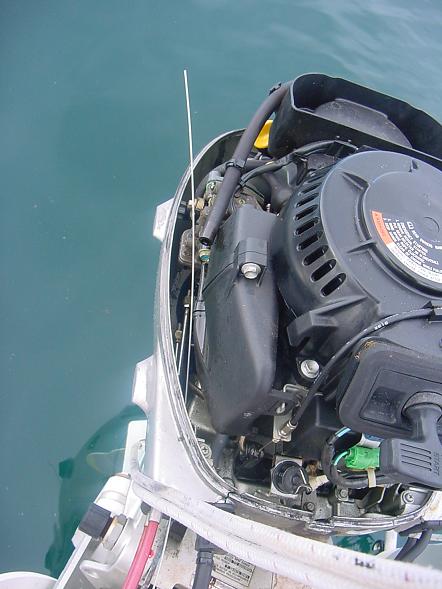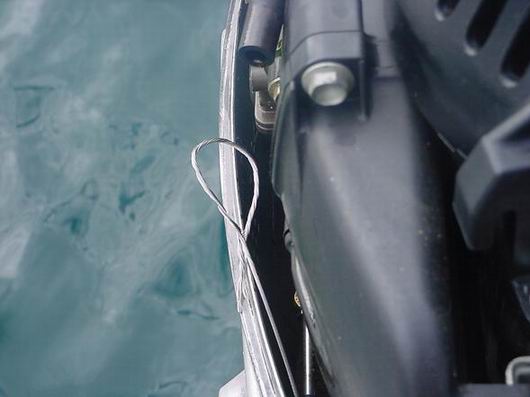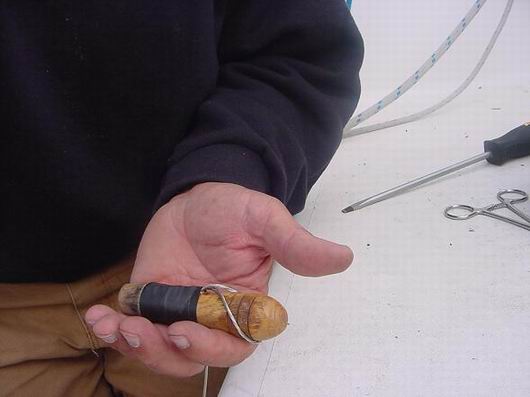It is human nature that the first reaction to a problem is denial in the hopes it will simply go away. If the problem does simply go away it wasn’t a problem at all. After only a moment, I knew this problem was not simply going to go away.
By now you’re thinking, “Go from one crisis to another! Is this all this guy does?” Well, that’s pretty much the picture. But that’s sailing in a hostile environment, a long way from help, of any kind, alone. By presenting these situations to you and the solutions I come up with I hope to stimulate your own thought processes as to how you would handle things when you sail into your great adventures what ever they may be.
What now is simply a great problem of great inconvenience only moments before could have been much more had it happened while crossing the threshold into safe harbor. Oh, I had my plans and I had my sail set and I could have gone this way or another and on and on… but this is about what did happen and how I did act and the results of that action.
Recall those words now, that launched the greatest rescue attempt of the 20th Century, “Houston, we have a problem.” I admit I have a problem. I define my problem. I have put the engine in reverse then attempted to put it back into forward. It stays in reverse even though the shift/throttle lever is moved into the forward position. The engine stays in reverse and throttles up in RPM. I start a mental list of what could be wrong: Broken cable, lose cable, something broken or lose inside the remote control system, or worse, lost transmission, broken levers, spun hub, (I don’t know exactly what a spun hub is but it used to happen a lot on the outboard motors in fleet of boats at Clean Sound, Inc.) gear box gone out, propeller fell off…enough!
First things first. I must get to anchorage and I won’t be sailing forward in these light airs with an engine in reverse. I kill the engine. I can not restart the engine. The cutout switch which prevents the engine from starting in gear is working just fine. Now I have two problems.
I anchor as described before. I awake at my usual 0500 in time to witness the beauty of yet another Labrador sunrise. I make my coffee and think. I get ready for the day and think. The first order of business in this day, find the true source of the problem.
After dismounting the Remote Shift/throttle unit, I open it and inspect its marvelous design. It moves two cables, one the throttle and the other the shift linkage in unison but at different rates and different lengths of travel and in two different directions, all with one lever. Sounds complicated? Well, it is. The shift lever must only move a short distance from neutral to forward then back to neutral to reverse then back while the throttle must move from idle to fast and all points in between in a smooth action. I look for the obvious. Is the cable visibly broken? No. Is it disconnected? No. Does it move with the lever? Yes. Reassemble. Remount.

Engine with cowling off
Move back to the engine, and open it up. To do this I have to partially hang off the end of the boat. I check my safety line yet one more time and contort my body through the gantry and out over the engine. Inside I find the levers the cables are connected to. Going back from the stern to the cockpit I watch for the actions and reactions of the Remote on the engine levers. My observation: the throttle cable moves as it should, the shift cable does not. I gain hope from that. It really is a broken cable on the inside of the shift cable. By using a pair of pliers I can actually shift the engine into neutral and start the engine. This is getting better and better. Not creating a new problem faster than I can solve the old problem is at the forefront of every move. Frustration and anger are to be avoided at all cost. I’ve seen men break fixable things irreparably in anger at an inanimate object. (Heck, what am I saying? I’ve done it myself!) If I have to try and fail and try again, so be it. I keep my sense of gratitude that I may just have on board everything I need to make it work.
Something happens, if I manually shift the engine into gear, I can then shift it out of gear using the Remote Shifter. This is indicative of a broke cable in a tight housing such that it can push but not pull. I catch an imaginary vision of the solution, how to shift the gears on the little-engine-that-could from the cockpit while sailing the 300 or so miles back to Goose Bay.
Oh, my friends, isn’t it interesting that the solution to this critical problem is rooted in the solution the father and son team engineers at Birdwell Machinery used to solve the rigidity problem with the gantry they built for me 6000 miles way and a year and a half ago. They used thin stainless steel cable to X the gantry, thereby giving it remarkable strength and stiffness. The same roll of extra cable left over from that solution is the same cable that I squirreled away, the same thin s/s cable that I used to clear the cooling water port when the engine wouldn’t pee, and it has once again come to my rescue.
And did it work? Well, I’m writing this moored to the public dock at Nain, Labrador!
Here’s how.
I threaded the wire from the cockpit to the engine through the cable run. Then, I drilled a hole in the rubber gasket that holds the shift/throttle cables and threaded it into the engine compartment. Once inside I put a Molly Hogan eye splice in the end of the wire and looped the end over the engine shift lever after wrapping it around the cable once to help hold it in place. I added a sail twine constrictor knot to hold the two cables together and help the eye splice not jump off.

Molly Hogan eye splice looped over the engine shift lever
At the cockpit side, I put another Molly Hogan eye splice in the end of the measured and cut cable and make a handle from a discarded file handle. (I’m a sailor. I save everything that might prove useful.)

Makeshift handle
I tested it and it worked. The s/s cable will get it into forward and out of reverse. The broken cable will still get it out of forward and into reverse. How long will it work? I don’t know. Is it the final solution? No, but for now I call it “My Come-Home Cable.”
PS Special thanks to Larry Smith. He’s a part of my “brain trust” in solving engine problems and went out of his way to help with the solution. Great minds work alike! It gave me confidence when he offered the same solution of using the cable I had mentioned before. “Together we are smarter than anyone of us alone.”
Note: The splice I call the “Molly Hogan” is simply the unlaying of a cable then reversing the direction and relaying it back together to form an eye. It is strong and very useful. You may know it by other names like Yachtsman’s Splice. I like Molly Hogan best because it conjures up thoughts of some young girl dressing like a man to go to sea in years by-gone and showing the guys how it’s really done! Some of the best sailors I know are ladies.
